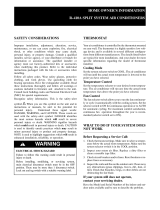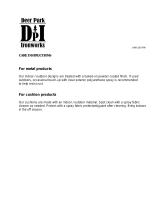Page is loading ...

428 02 5000 02 1
HOME OWNER’S INFORMATION
Split System Heat Pump
THERMOSTAT
Your Heat Pump is controlled by the thermostat mounted on
your wall. The thermostat is a highly sensitive low voltage
device and is available in several different configurations from
different manufacturers. The details listed below are typical for
most installations. Ask your dealer for more specific
information regarding the model of thermostat installed.
Heating Mode
Set the system selector switch to HEAT. The heat pump will
run until the actual room temperature is raised to the point
you have selected.
NOTE: you may see steam (looks like “smoke”) coming
from the outdoor unit during cold weather. This is normal as
frost is removed from the coil during the defrost cycle.
Cooling Mode
Set the system selector switch to COOL. The heat pump will
run (as an air conditioner) until the actual room temperature
is lowered to the point you have selected.
Temperature Control
Set the temperature selector to your desired room
temperature. For heating, the heat pump will run any time
the actual room temperature falls below the point you have
selected. For cooling, the heat pump will run (as an air
conditioner) any time the actual room temperature rises
above the point you have selected.
Fan Control
The fan selector switch allows you to run the fan
continuously or cycle it automatically with the heating or
cooling system. Set the selector switch to ON for continuous
operation or to AUTO for automatic cycling. For maximum
comfort satisfaction, continuous fan operation throughout
the year is recommended (selector switch set to ON).
WHAT TO DO IF YOUR SYSTEM DOES
NOT WORK
Before Requesting a Service Call:
1. Check thermostat settings. If you desire heat, make sure
to select a temperature above the actual room
temperature, and set the system selector switch to
HEAT. If you desire cooling, make sure to select a
temperature below the actual room temperature, and set
the system selector switch to COOL.
2. Inspect your return air filter. Replace a dirty filter or clean
a reusable type filter.
3. Check circuit breakers and/or fuses. Reset breakers or
replace fuses as necessary.
4. Inspect the coils and fins on the outdoor unit. Clean away
any obstructions (grass clippings, leaves, dirt, dust, or
lint). Check that branches, twigs, or other debris are not
obstructing the fan blade.
If your system still does not operate, contact
your servicing dealer.
Have the Model and Serial Numbers of the indoor and
outdoor units available and be sure to describe the problem.
REGULAR MAINTENANCE
REQUIREMENTS
Your system should be regularly inspected by a qualified
service technician. Between visits, there are some routine
maintenance procedures you can do to help keep your
system operating at peak performance.
!
WARNING
ELECTRICAL SHOCK HAZARD
Failure to turn off electrical power could result in per-
sonal injury or death.
Turn OFF all electrical power to both the indoor and
outdoor units before performing any maintenance or
removing any panels or doors. There may be more
than one electrical disconnect switch.
Air Filter
Inspect air filters at least monthly and replace or clean as
required. Disposable type filters should be replaced.
Reusable type filters may be cleaned by soaking in mild
detergent and rinsing with cold water. Install filters with the
arrows on the side pointing in the direction of air flow.
Dirty air filters are the most common cause of
inadequate heating or cooling performance, and of
compressor failures.
Condensate Drain
The indoor coil condenses water from the air, and this water
must be disposed through an appropriate drain system.
During the cooling season check at least monthly for free
flow of drainage and clean if necessary.
Outdoor Unit Coils
Grass clippings, leaves, dirt, dust, lint from clothes dryers,
and fall−off from trees can be drawn into coils by movement
of the air. Clogged outdoor coils will lower the efficiency of
your unit and could cause damage to the compressor. Clean
debris away from the outdoor coils.
Use a soft bristle brush with light pressure only. Do not
damage or bend coil fins. Damaged or bent fins may affect
unit operation.
Painted Surfaces
In geographical areas where the water has a high
concentration of minerals (calcium, iron, sulfur, etc.) it is
recommended that lawn sprinklers not be allowed to spray
on the unit. Spraying this type of water on the unit may result
in premature deterioration of the paint finish and metal
components.
Never use a weather cover over the outdoor unit unless it is
a ventilated type or made of breathable fabric that will allow
moisture to evaporate rapidly. A cover that holds moisture
in the unit will cause more rust build−up and damage than
normal exposure to weather.

428 02 5000 02 2
Copyright 2013 International Comfort Products
START−UP CHECK SHEET
Split System Heat Pump
INSTALLER: PLEASE LEAVE THIS AND ALL DOCUMENTATION WITH HOME OWNER
Date of Installation:
Installer’s Name:
Installer’s Address:
Installer’s City, State (Province), Zip (Postal Code):
Installer’s Phone:
Model Number:
Serial Number:
Mounting Pad properly sized, stable, and secure? o..........................................
Clearances around unit as specified in Manual? o............................................
Voltage as specified on unit nameplate? o..................................................
Overcurrent Protection Device (Breaker or Fuse) does not exceed amperage
listed on unit nameplate? o................................................................
Wires sized for Minimum Circuit Ampacity as listed on unit nameplate? o.......................
Indoor coil has hard shut−off TXV for proper refrigerant (R−410A or R−22) or Piston matching
the number (size) marked on outdoor unit? o................................................
Outdoor piston size matches number on unit nameplate? o...................................
Line set tubes not touching foundation, floor/ceiling joists, or wall studs? o......................
Line set suction tube fully insulated? o......................................................
Refrigeration system checked for leaks? o..................................................
Refrigeration system evacuated (vacuum pump) thoroughly? o................................
Refrigerant charge adjusted, if necessary? o................................................
All electrical disconnects returned to ON position? o..........................................
Complete system (indoor and outdoor) operated for 15 minutes? o.............................
Outdoor fan turning normal? o.............................................................
Compressor operating normal? o..........................................................
Comments:
/

